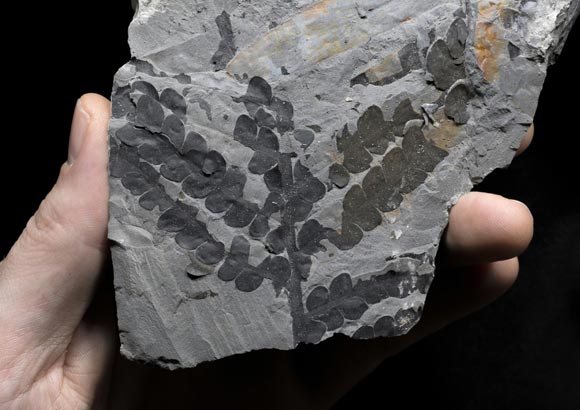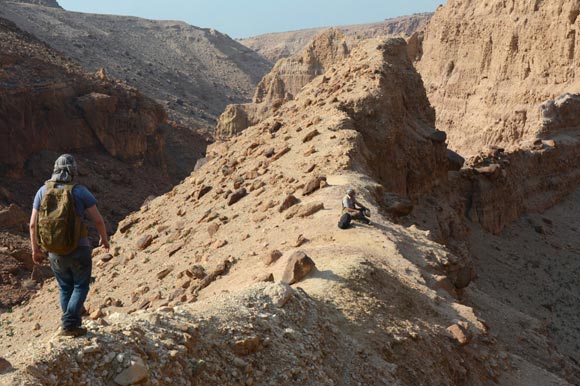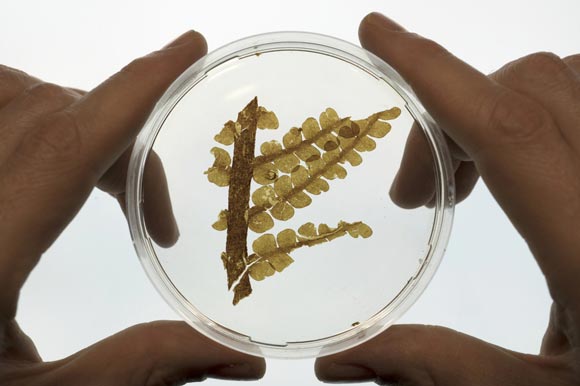Scientists Publish Seminal Research into Plant Fossils
Permian Tropical Lowlands – A Hot Spot for Plant Evolution
Over recent days, team members at Everything Dinosaur have been reviewing the breadth and scope of the articles posted on this blog in the last twelve months. The number of Sauropodomorpha themed articles (sauropods and their ancestors), has been commented upon. There have certainly been some amazing early, long-necked dinosaur discoveries, but we have also had a lot of exciting fossil discoveries concerning the Plantae Kingdom to write about too. In 2019, we have reported on research that suggests the very first land plants evolved earlier than previously thought. We have also written about new compelling evidence that suggests that flowering plants (angiosperms), were present during the Middle Jurassic.
The Preserved Remains of a Seed Fern (Upper Permian Deposits – Jordan)
Picture credit: Palaeobotany Research Group, University of Münster/Blomenkemper et al
It seems fitting that our last post for 2019, once again looks at some remarkable plant fossil discoveries.
Scientists led by palaeobotanists from the University of Münster (western Germany), have uncovered a series of well-preserved fossils representing important plant groups from Upper Permian rocks at a site in Jordan. The location, on the Dead Sea, has revealed the fossils of three major plant lineages:
- Podocarpaceae – a type of conifer, an evergreen tree
- Corystospermaceae – a type of seed fern (Pteridosperm)
- Bennettitales – cycad-like plants which produced seeds in cone-like structures
All the fossils pre-date the End-Permian extinction event that wiped out around 95% of all the life on our planet and the fossils prove that all three plant groups evolved millions of years earlier than previously thought. For example, the now extinct Bennettitales were thought to have evolved sometime in the Triassic. These fossils confirm that their evolution took place much earlier and that all three types of plant evolved before and persisted through the greatest mass extinction event known in Phanerozoic Eon.
A “Hidden Cradle of Plant Evolution”
Fossilised twigs representing the Podocarpaceae, commonly referred to as southern conifers, as the vast majority of extant species are found in the Southern Hemisphere, have been found. These fossils represent the oldest record of any living conifer family. In collaboration with colleagues from the Smithsonian Institute (USA) and scientists from the University of Jordan, the team also discovered the preserved, carbonised leaves and reproductive organs of Corystospermaceae, a group of seed ferns that went extinct some 150 million years ago, as well as remains of Bennettitales, a peculiar lineage of extinct seed plants with flower-like reproductive organs.
Trekking Through the Wadis on the Dead Sea Coast Looking for Plant Fossils
Picture credit: Palaeobotany Research Group, University of Münster/Blomenkemper et al
Evidence for the unexpectedly early occurrence of Corystospermaceae in the Permian of Jordan was first published about ten years ago by a research team led by Prof Dr Hans Kerp. Since then, researchers have uncovered not only the well-preserved leaves but also the characteristic reproductive organs of this group of plants. Like Bennettitales and Podocarpaceae, these plants were believed to have evolved millions of years later during the Early Mesozoic.
One of the co-authors of the scientific paper, published in the journal “Science”, Benjamin Bomfleur (Palaeobotany Research Group, University of Münster), stated:
“Analysis of characteristic epidermal cell patterns enabled us to resolve the systematic relationships of the plant fossils more precisely. The study area is really exceptional, like a melting pot of floral provinces.”
An Unusual Mix of Plant Taxa
The researchers noted that the plant fossils at the site represent a diverse and very mixed assemblage of plant types. The sedimentary deposits were laid down in an equatorial coastal environment with a distinct dry season – an ecosystem that rarely preserves delicate plant fossils. The scientists conclude that, early evolutionary innovations can occur in drought-prone tropical habitats which rarely offer the conditions needed for fossil preservation.
Dr Bomfleur added:
“The occurrence of no less than three major ‘modern’ plant groups in deposits of just this single rock formation may indicate that such stressed and disturbance-prone tropical environments may have acted as evolutionary cradles also for other plant groups.”
Exquisite Details Revealed by Acid Etching
Once the fossil material had been collected by the field team, a variety of methods were employed in the preparation laboratory to help identify the plant types the fossils represented. Powerful acids were used on some specimens to prepare plant cuticles for detailed microscopic analysis. It can be very difficult to distinguish pteridosperms from ferns based on foliage alone. Similarly, the fossil leaves of cycads are very difficult to tell apart from those of true Bennettitales. Identification is usually confirmed by examining microscopic details preserved in cells and on the cell wall of the cuticle, hence the need to use a variety of delicate techniques to reveal fine details.
Careful Exposure to Acids Helps Prepare Delicate Fossils for Microscopic Analysis
Picture credit: Palaeobotany Research Group, University of Münster/Blomenkemper et al
Survivors of a Mass Extinction Event
The plant fossils have been dated to approximately 255 million years ago (Lopingian Epoch of the Late Permian), so this ecosystem existed just a few million years prior to the “Great Permian Dying”, a mass extinction event that devasted both marine and terrestrial ecosystems. The unexpected discovery of these three main groups of plants prior to this extinction event, not only pushes back the origins of these plant types in time, but also proves that all three groups survived the End-Permian extinction event.
Some of these lineages appear to span the mass extinction event, which suggests that the communities they supported may have been more stable than expected over this period of dramatic transition and change. Thus, early evolutionary innovations can occur in drought-prone tropical habitats, which rarely offer the conditions needed for fossil preservation. Seasonally dry tropical environments could be described as “cradles of evolution”.
The scientific paper: “A Hidden Cradle of Plant Evolution in Permian Tropical Lowlands” by Patrick Blomenkemper, Hans Kerp, Abdalla Abu Hamad, William A. DiMichele and Benjamin Bomfleur published in the journal Science.
Everything Dinosaur acknowledges the assistance of a press release from the University of Münster in the compilation of this article.
To read Everything Dinosaur’s blog post on the idea that the first land plants evolved millions of years earlier than once thought: Plants May Have Originated 100 Million Years Earlier.
To read Everything Dinosaur’s article about the discovery of fossils representing very early flowering plants: The First Flowering Plants Originated in the Early Jurassic.
Visit the Everything Dinosaur website: Everything Dinosaur.




